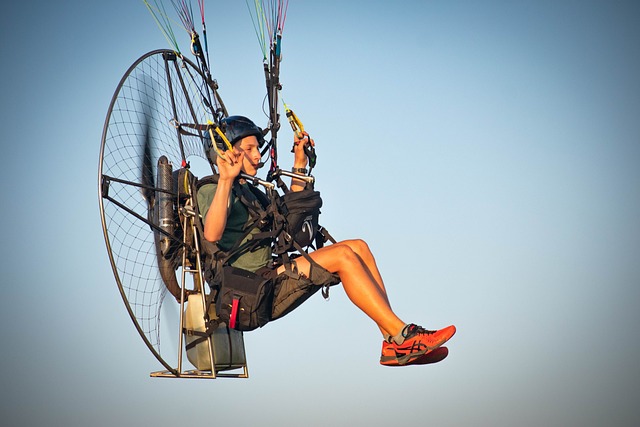Powered paragliding, also known as paramotoring, is an exciting and accessible form of aviation that has been growing in popularity over the past few years. One of the questions that people who are new to the sport often ask is, “how fast do powered paragliders go?”
Powered paragliders can travel at speeds between 25 to 45 miles per hour (40 to 72 kilometers per hour) on average, depending on factors such as engine power and thrust, wing size and shape, pilot weight and skill, and wind conditions. However, some high-performance models can reach speeds up to 60 miles per hour (97 kilometers per hour).
It’s important to note that flying at high speeds can increase the risk of accidents, so it’s crucial to prioritize safety by receiving proper training, maintaining equipment, checking weather conditions, wearing safety gear, setting altitude limits, and assessing risks. Knowing the speed of a powered paraglider is important for a number of reasons, including safety, planning flights, and understanding the capabilities of different types of paragliders.
In this blog post, I will explore the factors that affect the speed of a powered paraglider, average speeds for different types of paragliders, world records for powered paragliding speed, safety considerations for high-speed flying, and more. By the end of this post, you’ll have a better understanding of how fast-powered paragliders can go and what you need to know to fly them safely.
Factors that Affect the Speed of a Powered Paraglider
Several factors can affect the speed of a powered paraglider, including:
- Engine power and thrust: The power and thrust of the engine are one of the biggest factors affecting the speed of a powered paraglider. A more powerful engine can generate more thrust and achieve higher speeds, while a less powerful engine will have lower speeds.
- Wing size and shape: The size and shape of the wing also play a role in determining the speed of a powered paraglider. A larger wing can generate more lift and achieve higher speeds, while a smaller wing will have lower speeds.
- Pilot weight and skill: The weight and skill of the pilot can also affect the speed of a powered paraglider. A heavier pilot will require more power to achieve the same speed as a lighter pilot, while a more skilled pilot can optimize the wing and engine performance to achieve higher speeds.
- Wind conditions: Wind speed and direction can have a significant impact on the speed of a powered paraglider. A headwind will slow down the aircraft, while a tailwind can increase speed. Crosswinds can also affect the stability of the wing and make it more difficult to maintain speed.
Average Speeds of Powered Paragliders
The speed of a powered paraglider can vary depending on the factors mentioned above, as well as the type of paraglider being used. On average, powered paragliders can travel at speeds between 25 to 45 miles per hour (40 to 72 kilometers per hour). However, some high-performance models can reach speeds up to 60 miles per hour (97 kilometers per hour).
Different types of paragliders can have different average speeds. For example, a beginner or intermediate-level paraglider may have a top speed of around 25-30 miles per hour (40-48 kilometers per hour), while a more advanced and high-performance paraglider can reach speeds of up to 45-50 miles per hour (72-80 kilometers per hour).
It’s worth knowing that the speed of a powered paraglider can also be affected by altitude, air density, temperature, and other environmental factors. As I said before flying at high speeds can increase the risk of accidents, so it’s important to always follow safety guidelines and regulations when flying a powered paraglider.
World Records for Powered Paragliding Speed
There are several world records for powered paragliding speed, which are recognized by the Fédération Aéronautique Internationale (FAI). These records are divided into different categories, including speed over a straight course, speed over a triangular course, and speed over a closed circuit.
The current world record for powered paragliding speed over a straight course is 69.56 miles per hour (111.91 kilometers per hour), set by Ramon Morillas from Spain in 2009.
The world record for powered paragliding speed over a triangular course is 53.89 miles per hour (86.72 kilometers per hour), set by Glenn Tupper from the United States in 2015.
The world record for powered paragliding speed over a closed circuit is 61.53 miles per hour (99.03 kilometers per hour), set by Mathieu Rouanet from France in 2015.
It’s important to note that these world records were achieved by highly experienced and skilled pilots in ideal weather and wind conditions. Attempting to break these records without proper training, experience, and safety precautions can be extremely dangerous.
Safety Considerations for High-Speed Powered Paragliding
Flying a powered paraglider at high speeds can be thrilling, but it also comes with increased risks and safety considerations. Here are some important safety tips to keep in mind when flying a powered paraglider at high speeds:
- Proper Training: It’s important to receive proper training from a certified instructor before attempting to fly a powered paraglider at high speeds. This will ensure that you have the necessary skills and knowledge to handle the aircraft in different weather conditions and situations.
- Equipment Maintenance: Regularly maintaining and inspecting your equipment can help prevent accidents and ensure that your aircraft is functioning properly. Always check your engine, wing, harness, and other equipment before every flight.
- Weather Conditions: Weather conditions can have a significant impact on the speed and stability of a powered paraglider. Always check the weather forecast before flying and avoid flying in strong winds or turbulent conditions.
- Safety Gear: Wearing proper safety gear such as a helmet, gloves, and other protective clothing can help reduce the risk of injury in the event of an accident.
- Altitude Limits: It’s important to know your altitude limits and avoid flying at high speeds close to the ground or obstacles. Always maintain a safe altitude and distance from other aircraft or objects.
- Risk Assessment: Before flying at high speeds, always assess the risks and potential hazards of the flight. If you’re not comfortable or confident in your ability to handle the aircraft, it’s better to avoid high-speed flying altogether.
By following these safety considerations and guidelines, you can minimize the risks and enjoy the thrill of powered paragliding at high speeds safely.
Conclusion
In conclusion, powered paragliding is a thrilling and accessible form of aviation that can reach speeds of up to 60 miles per hour (97 kilometers per hour). The speed of a powered paraglider is influenced by several factors, including engine power and thrust, wing size and shape, pilot weight and skill, and wind conditions.
There are also world records for powered paragliding speed, which should only be attempted by highly experienced and skilled pilots in ideal weather and wind conditions.
Flying a powered paraglider at high speeds can be an exhilarating experience, but it’s important to prioritize safety by receiving proper training, maintaining equipment, checking weather conditions, wearing safety gear, setting altitude limits, and assessing risks.
I hope that this post has provided you with valuable insights into the speed of powered paragliders and the safety considerations that come with flying them at high speeds. Remember to always prioritize safety, and enjoy the thrill of powered paragliding responsibly.
You might also be interested in knowing for how long a paramotor can fly.










